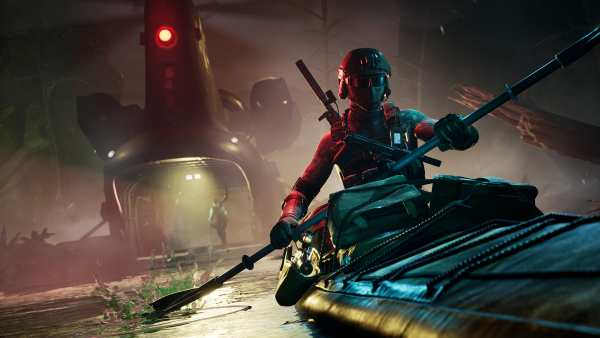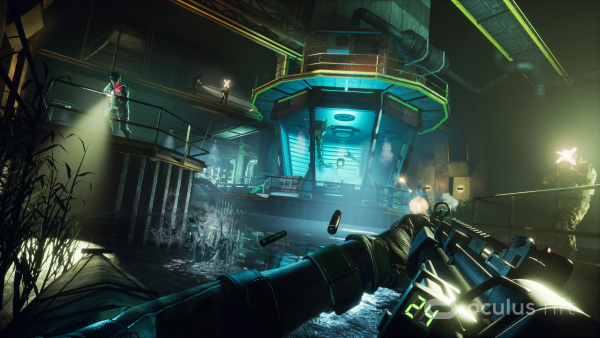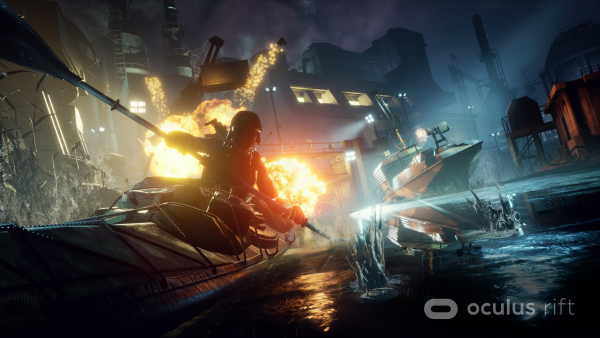Phantom: Covert Ops is available now on Oculus Quest and Rift headsets! In the runup to launch, Oculus sat down with the game's Art Director Glenn Brace to talk inspirations, development and VR...
What was the inspiration behind Phantom: Covert Ops? How has the game changed over time?
Glenn Brace: The inspiration was a coming together of a few things, all at the right time.
As a studio we we’re very focused on pushing long-form game concepts that really push VR. But there were known challenges: first-person shooting mechanics and pace in VR, challenges with freedom of movement, fidelity of rendering, and world exploration were all well-documented issues or sometimes criticisms of existing larger VR titles.
At that point in time, we were prototyping various traversal mechanics whilst also developing an arcade shooter. Those two things plus a personal passion and previous dev experience in stealth action titles made for the “ground zero” point of Phantom’s conception.
An initial team and prototype were quickly put into motion. Then the penny dropped... a way to combine all three elements, that happened to tackle some of the larger problems we faced and contextualize them in cool way that gifted us the perfect and unique 1:1 traversal mechanic we’re still loving today.
The initial pitch and contextualization for the kayaks was based around the true heroism of the WWII Special Boat Service (SBS), teams known as the Cockleshell Heroes, who raided the occupied ports and shipping fleets deep within northern France.
As we continued to prototype, explore new features, and add more tools for the player, we discovered the intensity and emotion experienced during gameplay. The importance of the roleplay and sense of presence within Phantom was soon realized, a careful balance between traditional gameplay mechanics and the theatrical “acting out” helped reshape the game into the more cinematic experience we are dealing with now.
How long was the game in development? Any favourite anecdotes you’d like to share?
GB: The game has been in development for nearly two years now.
As for anecdotes, “Tac-Yak.” It was coined by the guys at Giant Bomb, but god damn, I wish I came up with that years ago! Saying, “canoe,” in a boardroom full of execs followed by, “Trust me, play it.” Man, if I could have just hit them with “Tac-Yak” then I would have had a much easier time convincing people earlier on.

How did you get the look and feel just right?
GB: Well this was one of the most fun, perhaps even dogmatic bits!
Being involved with early VR development, we were quite clued-in to the various performance issues and hardware limitations that surround VR, etc. Against common conjecture within the gaming industry, I was convinced that you could create contemporary console fidelity and graphics for VR in a fully explorable world—basically do the thing people say can’t be done! That brief and determination became a backbone to Phantom’s visual pillars.
We did have a challenge to raise VR expectations, but we had a great grounding to achieve it. Our visual pillars were carefully iterated based on a beautiful fusion between hardware limitations and creative context. If we picked our battles appropriately, we could really punch above our weight.
This incredibly focused visual style and context afforded us the opportunity to really aim our technical team all in the right places. The support we had from our graphics and tech team was second to none. Our code team built on top of UE4 systems to allow us to “amp up” our ability to deliver heavy atmosphere, impressive water, massive environments, and most importantly, outstanding flexibility in lighting.
The resulting theatrically lit, atmospheric, and cinematic rendering style all helped amplify the emotional experience, delivering unique and contemporary visuals in a fully explorable world.
The harmony between hardware and art direction has enabled more than we even originally anticipated.
How did your previous work in VR help inform your work on Phantom?
GB: Absolutely loads! I’d go as far as to say that Phantom represents the accumulation of many years in VR by both myself and my comrades into one complete experience.
Working through the early days of VR has afforded me quite a holistic education. From the importance of legibility and visual clarity and tricks to achieve those, to challenging the preconceptions of game development, prototyping beyond known mechanics, and truly exploring what VR has to offer as a real next-generation gaming platform.
Any cultural references players should be on the lookout for?
GB: There are several references players can look out for in Phantom—from stealth gaming (Metal Gear series, Splinter Cell) to inspiration from the WWII SBS, on through to ’90s military hardware details (NATO / Warsaw), plus Noir lighting models to name a few!

What’s the best reaction you’ve seen so far when demoing the game?
GB: My son Maximilian (10 years old) playing the E3 demo in June 2019.
He was the perfect candidate. He was so fearful of getting spotted, his natural survival instincts just kicked in. The tension the kid felt was unbelievable to watch. With literally no introduction or tutorials, it was a testament to the literal, 1:1 nature of the interactions and spatial awareness you get only from VR.
It was a crazy mix of proud—proud when Max kicked ass as a Spec Ops combatant, but also a stark realization of what we as a team have achieved.
What’s your favourite part of the game and why?
GB: We’ve not revealed my favourite part of the game yet. But let’s just say I love the fact we take the kayak to places you never thought to go. As the game progresses, we break out of the obvious rivers and natural waterways into areas offering unique perspectives not really seen before.
What advice would you give to a developer looking to start building for VR?
GB: Make sure you consider the differences VR offers compared to traditional 2D gaming. Not just hardware limitations, but more what makes a compelling VR game.
Roleplay and gameplay sometimes do not play nice together, figuring out how they both coexist and allowing time and space for both is a tricky balance, but one that needs to be struck.

What’s next for you? Any exciting updates in the works?
GB: Well I feel like a kid in a toy shop right now. VR hardware and installations are evolving at an alarming rate. There’s already new tech I want to get to grips with both for the home and commercial markets.
Going back to previous sentiments, I really do believe VR is the real next-gen hardware, and with that, I feel there are new genres of games, arcade and experiences we’re yet to discover and establish.
Anything else you’d like to share with our readers?
GB: Evangelize VR. If you love it, tell and show everyone—wherever and whenever possible! Help get people’s heads into VR headsets.
The sooner we hit mass adoption, the better for everyone. That’s when things will explode, and that’s when we’ll be experiencing the now unimaginable.
I want to be there for that, so let’s make it happen.
Phantom: Covert Ops is available now on Oculus Quest and Rift Platforms! Be sure to follow us on Twitter, Facebook, LinkedIn, and YouTube for all the latest on future Phantom updates.